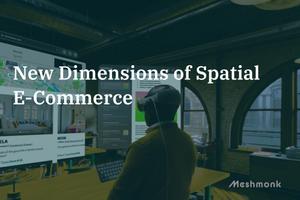New Dimensions of Spatial E-Commerce
Spatial computing, a term coined by MIT Media Lab alumni Simon Greenwold in 2003, represents the convergence of the physical and digital worlds. It involves the digitization of interactions involving people, machines, objects, and their environments. This technology leverages artificial intelligence (AI), camera sensors, computer vision, the Internet of Things (IoT), and augmented reality (AR) to transform how we interact with the digital world.
The Mechanism Behind Spatial Computing
Spatial computing transcends traditional 2D computing by integrating data, logic, and 3D-contextualized information. It utilizes a plethora of data sources, including IoT sensors and 3D models, combined with sophisticated analytics and 3D-location data enabled by computer vision and volumetric cameras. This approach contextualizes data in a three-dimensional world, enhancing real-time collaboration, training, customer service, and sustainability efforts. Platforms like MeshMonk utilizes latest Spatial computing technology in e-commerce platforms like Shopify
Spatial Computing in E-Commerce
1. Virtual Shopping Experiences
Spatial computing is revolutionizing e-commerce by enabling virtual shopping experiences. Customers can “try on” clothing virtually or see how products might look in their environment before making a purchase. This immersive experience is made possible through AR and VR technologies, providing a more interactive and personalized shopping journey.
2. Enhanced Customer Service
In the realm of customer service, spatial computing allows for more engaging and efficient interactions. For instance, in an industrial metaverse, a remote expert can have a hands-on, contextualized spatial view of a problem, enabling them to troubleshoot alongside an on-site worker.
3. Optimizing Retail Spaces
Spatial computing also plays a crucial role in optimizing retail spaces. By digitizing the activity of people, machines, and objects within a store, retailers can discover meaningful interactions and relationships, enabling them to optimize layouts and processes for better customer experiences and operational efficiency.
The Future of Spatial E-Commerce
The future of spatial e-commerce is promising, with a projected global market growth reaching $620.2 billion by 2032. As the technology becomes more mainstream, we can expect to see its integration in various aspects of e-commerce, from virtual try-ons and immersive shopping experiences to enhanced customer service and optimized retail operations.
The market for spatial computing is rapidly growing, with its global value expected to reach $620.2 billion by 2032.
MeshMonk is a platform that revolutionizes e-commerce by integrating AI, spatial technology, and cryptocurrency to create personalized Web3 shopping experiences. Here’s how MeshMonk can help in various sectors:
- Fashion: MeshMonk offers a spatial commerce store for fashion, allowing users to unleash their style in a unique and immersive environment. This could mean virtual try-ons or exploring fashion items in a 3D space.
- Electronics: For consumer electronics, MeshMonk provides an experience that showcases the future of technology in an interactive manner. This could involve exploring electronic products in a virtual space, understanding their features and specifications in a more engaging way.
- Home Decor: MeshMonk enables the transformation of living spaces in real-time, allowing users to visualize home decor items in their own space. This can greatly enhance the shopping experience by providing a realistic view of how products would look in a customer’s home.
- Virtual Store Creation: Brands can create their own immersive virtual stores with full-motion camera movements and custom actions, providing a unique shopping experience that goes beyond traditional e-commerce websites.
- Customizable and AI-Driven: The platform is customizable to each brand’s needs and employs an AI-driven shopping assistant. This assistant analyzes shopping data and personal preferences to suggest products tailored to individual needs.
- In-World Payment Processing: MeshMonk facilitates in-world payment processing, making transactions seamless within the virtual shopping experience.
- Integrations: The platform offers integrations that stream interactive metaverse experiences straight to the browser, simplifying the process for both businesses and consumers.
In summary, MeshMonk helps by providing a plug-and-play environment for e-commerce brands to build spatial commerce experiences. These experiences are more immersive, interactive, and personalized, enhancing the overall shopping journey for customers in various sectors like fashion, electronics, and home decor.
Spatial computing is not just a futuristic concept but a present reality transforming the e-commerce landscape. By bridging the gap between the physical and digital worlds, it offers unprecedented opportunities for businesses to enhance customer experiences and streamline operations. As we continue to explore the possibilities of this technology, the future of e-commerce looks more interactive, efficient, and customer-centric.


